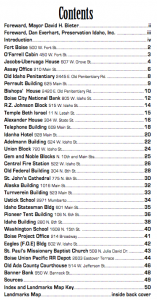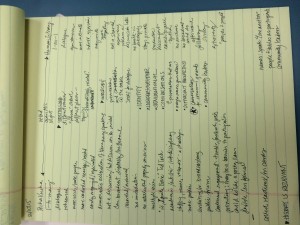Tom King: Our Unprotected Heritage
There are better ways of improving federal cultural and natural resources than writing a book littered with negativity, accusations, and blatant disdain for the hard work of civil servants who are employed to help you, me, and American resources.
Valuable reader’s time is invested (wasted?) in case studies that point fingers at various agencies…only to arrive at King’s last chapter that is a sketchy outline of the “problems” with a neat outline of suggested solutions. To say I was irritated is an understatement. Then, for King to acknowledge that he is a paid consultant – although he states not paid as handsomely as others – somehow therefore makes him any less of the problem…ugh.
Let me me really clear here: I am a retired federal employee of two of the agencies that King says represent the “bright” and “light” green laws of the United States: the Department of Interior’s Bureau of Land Management and Fish and Wildlife Service. Don’t get me wrong: there is plenty of room for improvement in both federal employee work and the laws themselves, but ditto that for the consulting agencies, federal contractors (including King), elected officials, and U.S. citizens. Everyone is responsible for our system, and everyone needs to step up to the plate. Seriously. There is plenty of blame to share – and quite frankly, King hit on very few of the solutions. Possibly if there was less complaining and finger-pointing, and if we work to BUILD trust, not TEAR IT DOWN, we may end up with more positive situations.
I simply cannot ascribe to a published rant that directly works to build distrust. Why? Consider the following:
Governor Butch Otter paid handsomely for mishandling dredge from his property in Star, Idaho, that ruined wetlands and threatened the Boise. No permit, and conservative politics on his side. Trustworthy federal – and state – employees worked within the law, and Otter paid over $50,000 in fines for his multiple violations, although he spent plenty money charging that he was cruelly and unusually fined. That is trust in your laws – and the civil servants who work to uphold those “process-laden, thank you Mr. King,” laws – regardless of whether they are “light or bright.”
If we – including Tom King – build distrust, we end up with Idaho’s brilliant Feb 2014 legislative bill that was introduced by Idaho Rep. Paul Shepherd who was unhappy with federal gold dredging laws. [NOTE: Shepherd’s attempt was to strip federal government authority of the EPA, specifically, but this also then defacto all the other consulting agencies such as Forest Service, BLM, Army Corps of Engineers and Fish and Wildlife Service, AND the state. This proposed bill supported mining’s dreadful environmental impacts on Idaho’s streams n the name of distrust of our government and it opened the door for more harm than good, based over personal rights. Shepherd’s words: “It appears the EPA bureaucracy has an agenda in its interpretation of what pollution is,” and the intent was to strip the feds of their “authority.” It is shared authority, and if members of the public work to tear it down, you get what you work for…even if you are a Tom King who leans more left than right. Eventually, Congress actively worked to deny critical funding to EPA, and ALL of the other agencies unless it touched ocean fishing, wildland fire protection, oil and gas drilling, or grazing rights. In the name of distrust of our own federal government. Got us far, right?
(Remember Cliven Bundy, all? Damn those feds, difficult public processes and closeted attempts, yes?)
So King thinks it is acceptable to just pile on more distrust? The net effect is vicious circle of litigation – no progress, as King blithely suggests his solutions will be. By the way FOIAs – which really are most cases are not necessary! Just ask and you receive. There is little that would ever not be released, unless they are records of internal discourse – which occurred every minute amongst federal employees in my experience, working to build trust in the system and collaboratives with – not against – the public, with one goal: to uphold natural resource conservation.
Government agendas…King agrees, obviously: “..even if you learn the systems, learn the specialized language, and push the right buttons, at the end of the day you’re still likely to see government agencies agree, over your head, to let your heritage go down the drain,” as if governments actively work to against its citizens. Or…another of King’s brash assumptions about the laws: “They apply mostly to federal agencies – in many ways they’re designed to protect us, the public, from our government.” Oh, please…
“The federal and state agencies responsible for overseeing the studies and keeping them honest usually view themselves – though they’ll seldom admit it – as being in the business of making sure projects go forward with as little impediment as possible from the environment. Or they’re mostly concerned with processing paperwork and protecting themselves, or they’ve turned into petty tyrants…” Huh. Let’s see, an example in Boise’s backyard – the foothills. Fish and Wildlife Service, BLM, NRCS, the State of Idaho – and several private property owners and Native Plant Society – were distraught over ATV use in the foothills that was tearing up precious sagebrush steppe, harming and taking rare plants and small ground mammals (damn that halfway light/bright Endangered Species Act, yes?), and causing habitat fragmentation, not to mention causing a visual and auditory blight. Solution: everyone worked together, trustfully. Public education, such as interp signs, workshops, and handouts, plus social media went up. One biologist, who barely weighs as much as the huge tractor tires that he lugged single-handedly to the foothills and joined with the rancher to place them strategically. A BLM raptor rec planner personally set posts for interp signs. A pregnant botanist worked overtime to help the rancher, and her counterparts worked one-on-one with the public to improve ATV use on private and public property. I can count handfuls of federal and state biologists, botanists, and public affairs people who worked tirelessly beyond just “processing paperwork” and being “petty tyrants” to achieve on-the-ground solutions- with TRUST. Oh, and no FOIAs needed. Net result = environmental protection, personal property rights upheld, and no “impediment” attitude.
King charges federal “Petty dictators” with “pro-forma public comment and public hearings are substituted for meaningful consultation with concerned parties.” Or…”Public hearings on the whole, are a water of everyone’s time – much like hearings in Congress. I’ve been in a lot of public hearings, both on the floor and at the podium, and I don’t think I’ve ever seen one that’s made any difference whatever.” Well, I have no idea if I have been to – or organized – more public hearings than Mr. King, but over 25 years I would be bet near fifty kept me working hours and hours – on and off that federal clock that King sees as wasteful….. Talk to the people of North Idaho who showed up for multiple public hearings and meetings over critical habitat for the Selkirk Mountains Woodland Caribou. That’s Randy Weaver territory, folks…people who may be on King’s other spectrum, but distrustful of government is an understatement. hundreds of citizens met on-on-one with Fish and Wildlife Service, not to mention the Forest Service and two Native American Tribes. County Commissioners also worked diligently with citizens and the feds to BUILD TRUST in their government, despite claims that the proposal would wipe out recreation, logging, and other personal rights to earning an income on public land. Third party review also happened ad infinitum, as occurs more often than King’s assertions, and respect for the “opinions of ordinary citizens” that King also charges does not occur (Chapter 8). Net result of Caribou public-government interactions: no FOIAs, productive meetings, no loss of personal income, and a final proposal that was 9/10 less than the proposed! Everyone won, including the caribou. Imagine that.
Lastly, USFWS and BLM are required right down to most administrative support personnel, to honor Native American tribal treaty rights. Mandatory training occurs, and that status s improving. With Caribou, bull trout, wolves, native plants, and more… respectful multicultural engagement is on its way to productive relationships on and off sacred cultural tribal grounds.
Mr. King, in response to your statement that fed natural resource and cultural agencies say, “Please don’t rock our boat,” I say – rock it. Come to the helm, and help steer some trust.

